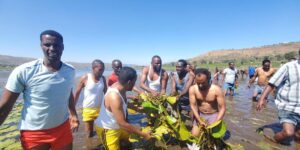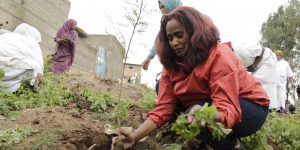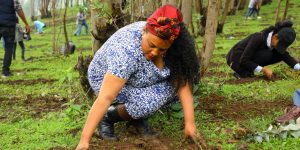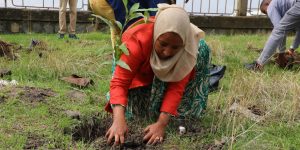President Sahle Work Zewde has visited the Somali region along with the Deputy Secretary-General of the United Nations and Chair of the United Nations Sustainable Development Group, Amina Mohammed and her team of delegates. They discussed with the president of the region Mustafa Mohammed and the officials of the region about the drought that is happening in the area.
They met with the displaced people that were due to visit the burial ground, to burry victims of the draught. The president thanked the Deputy Secretary-General for the greatness she has shown to the people of the region by being the first responders. They explained to the displaced that first aid is expected and the main goal is to help the displaced people return to their homes.
President Sahle-Work Zewde travelled to Somali region with UN Deputy Secretary-General Amina Mohammed and her delegation. The President of the region Mustafe Mohammed briefed the delegation on the drought situation in the region. During the field visit in Qebri Baya, President Sahle-Work thanked the host community for being the first respondent in supporting the IDPs.
THE DROUGHT BEYOND SOMALI REGION
Hopefully this wasn’t a mere photo opportunity scam, and politricks for president Sahle-Work Zewde and Deputy Secretary-General Amina Mohammed. The entire southern region needs urgent attention as the drought is in regions of Somali (10 zones), Oromia (8 zones), Southwest (1 zone) and Southern Nations, Nationalities, and Peoples – SNNP (7 zones).
The affected people of the drought need immediate assistance and not lip service. Instead of the federal government arresting journalists and regional officials that wanted to raise awareness of the drought, the government should put in place drought warnings systems and solutions for all places affected. However, the warnings were made, but the people supposed to have acted, just turned a blind eye.
The regional government should also be held accountable, for letting the situation get-out of hand. People living in these same areas, have barely managed to recuperate from the severe droughts of three years ago.
Apart from photo opportunities, the federal government is more interested in fighting wars it created in the first place, than acting quickly and solving natural disasters. A progressive government would have invested in artificial rain drone systems-than killer drones.
![]() Overall, the drought is currently affecting the livelihood of over 6.8 million Ethiopians across the drought-affected areas. The drought is worsening food insecurity and malnutrition, while pastoralists are forced to walk and travel longer distances in search of water and pasture.
Overall, the drought is currently affecting the livelihood of over 6.8 million Ethiopians across the drought-affected areas. The drought is worsening food insecurity and malnutrition, while pastoralists are forced to walk and travel longer distances in search of water and pasture.
![]()
Question remains; will the two ladies come out of their comfort zone and visit Tigray, or it’s too much to ask?? Anyway, we shall keep watching them!!
Ethiopia Autonomous Media
Latest posts by Ethiopia (see all)
- Lideta Sub City Woreda celebrated International Women’s Day - 11th March 2024
- THE AMHARA FANO FREEDOM FIGHTERS - 13th February 2024
- GREAT VICTORY FROM SHOWA GOVERNORATE - 12th February 2024




